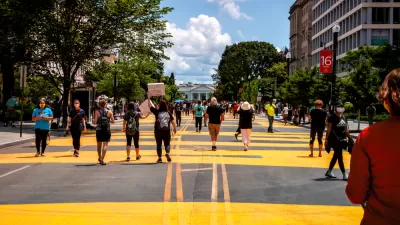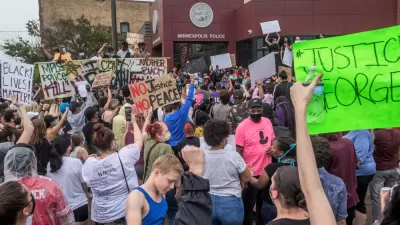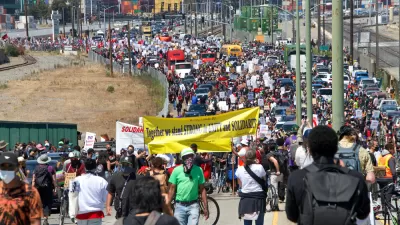The ongoing debate about the role of marginalized communities in the emergency planning programs of the pandemic has now been detailed on the pages of the New York Times.

An article by Emily Badger for The New York Times amplifies an ongoing debate about planning processes during the pandemic—emergency efforts to reshape the public realm to create more space for pedestrians and restaurant and retail businesses—failing the equity test of including marginalized and under-served communities.
The primary source for Badger's coverage of the debate is Destiny Thomas, whose writing on this subject was shared here on Planetizen in June, and who has also been a source in other articles raising the same issues.
Here's how Badger summarizes the debate:
Today, visions of urban life reinvented for the future are colliding with unaddressed inequalities from the past. And the urgency of a public health threat is pushing against demands for the long work of inclusion.
So the questions raised by the debate are questions about the fundamental processes and outcomes of planning: who gets to make the decisions about the future of cities and communities, and how are planners reckoning with the racist and discriminatory outcomes of previous generations of planning decisions?
As an example of the reforms proposed by Thomas, Badger includes the following:
Ms. Thomas, the anthropologist-planner, who leads a team of strategists called the Thrivance Group, says traditional public meetings aren’t her idea of engagement anyway. Instead, she suggests cities could fund community health clinics or food banks already serving these neighborhoods to engage residents on what they need from the city at the same time. City departments could also put community residents on staff to do this work. Ms. Lemar proposes using elementary schools to reach families who would never attend public meetings.
The article treats Oakland's slow streets specifically as a case study for the issues of representation and political power in planning during the pandemic, while raising the larger implications of those experiences for the practice of planning and community engagement for planners around the country by citing academics and advocates from around the country.
FULL STORY: The Pandemic Has Pushed Aside City Planning Rules. But to Whose Benefit?

Study: Maui’s Plan to Convert Vacation Rentals to Long-Term Housing Could Cause Nearly $1 Billion Economic Loss
The plan would reduce visitor accommodation by 25,% resulting in 1,900 jobs lost.

North Texas Transit Leaders Tout Benefits of TOD for Growing Region
At a summit focused on transit-oriented development, policymakers discussed how North Texas’ expanded light rail system can serve as a tool for economic growth.

Why Should We Subsidize Public Transportation?
Many public transit agencies face financial stress due to rising costs, declining fare revenue, and declining subsidies. Transit advocates must provide a strong business case for increasing public transit funding.

Columbia’s Revitalized ‘Loop’ Is a Hub for Local Entrepreneurs
A focus on small businesses is helping a commercial corridor in Columbia, Missouri thrive.

Invasive Insect Threatens Minnesota’s Ash Forests
The Emerald Ash Borer is a rapidly spreading invasive pest threatening Minnesota’s ash trees, and homeowners are encouraged to plant diverse replacement species, avoid moving ash firewood, and monitor for signs of infestation.

Agreement Keeps NYC Congestion Pricing Alive Through Summer
The tolling program will continue while a court considers the city’s lawsuit against the Trump administration.
Urban Design for Planners 1: Software Tools
This six-course series explores essential urban design concepts using open source software and equips planners with the tools they need to participate fully in the urban design process.
Planning for Universal Design
Learn the tools for implementing Universal Design in planning regulations.
Ascent Environmental
Borough of Carlisle
Institute for Housing and Urban Development Studies (IHS)
City of Grandview
Harvard GSD Executive Education
Toledo-Lucas County Plan Commissions
Salt Lake City
NYU Wagner Graduate School of Public Service





























